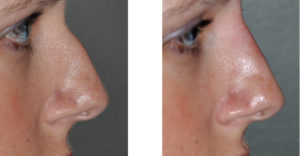
Doing injections into the nose for aesthetic augmentation has prove to be bth safe and effective but potential complications can occur….rare as it may be.When such complications occur they can be catastrophic with skin necrosis and tissue loss.
In the March 2020 issue of the journal Plastic and Reconstructive Surgery an article was published on this topic entitled ‘The Nonsurgical Rhinoplasty: A Retrospective Review of 5000 Treatments’. In this clinical paper covering a three and 1/2 year period, a single surgeon reviewed his experience in a large number of patients. His technique consists of using cross-linked hyaluronic acid gels (Teosyal and Perfectha) injected using a 0.3ml 30 gauge needle in micro droplets. A pinch test is used to check for skin laxity. If the skin envelope is tight, injections are avoided because of the increased risks associated with high pressure injection in a tight space. Injection principles include: 1) staying in the midline of the nose, 2) injecting at the perichondrial and periosteal level, 3) injecting slow at low pressure, 4) starting the injections at the radix and moving caudally to the tip, 5) injections aliquots lifted to 0.1ml or less and 6) massage of the gel at each injection point. Followup was done at 4 to 6 weeks after treatment.
The patient population was predominantly women (94%) of a young age. (mean age of 27 years old) The top three indications for the non-surgical rhinoplasty were dorsal hump reduction (44%), postsurgical correction (20%) and lifting if a dropping tip. (15%) The mean filler volume used was 0.7mls. The most common treatment complication was bleeding which was controlled by pressure. Immediate bruising occurred in a small number of patients. (2%) Arterial occlusion occurred in 0.5% of the patients and occurred most commonly at the nasal tip. This was treated by immediate cessation of the injections and massage and warm compresses. If vigorous massage did not cause a return of perfusion Hyaluronidase injections were done in the area of skin changes.
Temporary redness and swelling were the common adverse sequelae seen which developed in variable amounts in up to 30% of patients. Most of these occurred within 24 hours to up to two weeks after treatment which usually resolved by one week after injection but can take up to six weeks to do so. The most significant complications of variable amounts of skin necrosis occurred in three patients. (0.06%) Infection occurred in two patients (o.o4%)which resolved with antibiotics. The typical longevity of the result was 9 to 12 months. Up to 22% of the patients returned for a touchup injection treatment at 6 weeks after the first one.
This impressive clinical study demonstrates that injectable rhinoplasty is a safe and effective procedure with a very low rate of complications with proper patient selection and injection technique. A certain amount of swelling and redness will occur in some patients which is self-solving in most cases. Because of some swelling that occurs with the injections and bleeding, under correction is not rare and the need for a touchup injection is not uncommon. The injector should be prepared for the rare occurrence of vascular occlusion/compromise with immediate management strategies.
Dr. Barry Eppley
Indianapolis, Indiana


